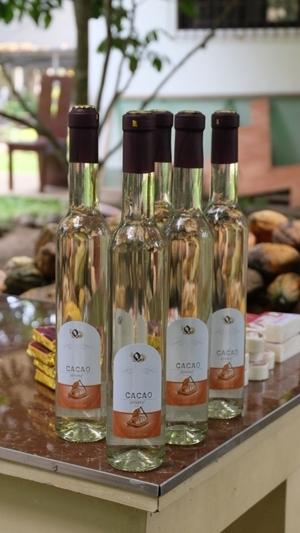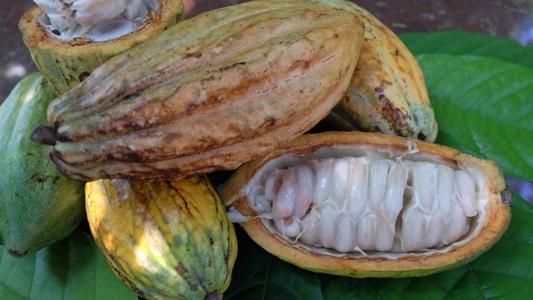Famous for being processed into chocolates, Theobroma cacao which literally means “food of the gods” started as a backyard industry in Region 4A.

“Ang cacao ay tinatanmin lang sa mga baku-bakuran at hindi ito isang pormal na industriya noong nakaraan,” according to Mr. Dennis Bihis, senior research specialist from the Quezon Agricultural Research and Experiment Station (QARES) of the Department of Agriculture-Regional Field Office (DA-RFO) 4A. He added, “ang produksyon ng cacao ay sinimulang umangat noong 2007. Kung [kailan] nagkaroon na ng mga programa upang magpatanim ng mas marami pang cacao at gawin pormal na industriya.”
The development of the cacao industry in the region started to grow to supply for the country’s production shortage. This led to the conduct of an agribusiness development project on cacao led by DA-QARES and funded by the Bureau of Agricultural Research under its National Technology Commercialization Program. He shared, “Nagkaroon kami ng proyekto sa cacao, iyong Agribusiness Development Project. Upang magkaroon tayo ng mga pananim at matulungan natin ang mga magsasaka sa teknolohiya ng pagpaparami.”
The success of this project was followed through by another project titled, “Cacao Commercialization in the Province of Quezon.” According to Mr. Bihis, project leader, “iyong second project natin ay ginawa natin upang palawakin iyong taniman ng cacao. Pangalawa, bigyan natin ng pagsasanay ang mga magsasaka upang mapaayos ang produksyon nito at hindi lang maging backyard kundi maging commercial iyong level ng produksyon. Pangatlo, mag-develop din ng mga produkto mula sa mga buto ng cacao. At pang-apat ay magkaroon ng promal na tie-up sa mga merkado.”
As part of the project, different product lines (i.e. table, cacao soap, cacao wine) were developed to provide farmers an additional source of income.
The cacao wine, as shared by Mr. Bihis, was developed “kasi masyado ng saturated ang merkado ng mga sabon, tableya. So kailangan natin ng ibang produkto na pwedeng pagkakitaan ng ating beneficiaries.” After developing the product, QARES submitted it for analysis and packaging. After which, the technology on cacao wine was disseminated to various associations and beneficiary groups including the Cacao Farmers’ Association of San Antonio, Quezon; and the Laguna Cacao Farmers Association, which were beneficiaries of the projects.

Cacao wine goes to Madrid Fusión Manila
On the second day of the Madrid Fusión Manila (MFM) 2017, the cacao wine of QARES was featured in one of the food presentations during the Regional Lunch sponsored by DA. Madrid Fusión, an international culinary event held yearly in Spain, is where international culinary legends and rising stars showcase new techniques and cutting-edge innovations, while paying tribute to culinary traditions from where these contemporary cuisines have sprung. Arguably, the MFM 2017 is one of the better arenas where local ingredients, products, and gastronomy talent can be featured and promoted as it has always been one of the biggest culinary events in the world.
In her creation dubbed as “A Toast to Chocolate” during the MFM 2017, Ms. Pamela Lim Cinco of Risa Chocolates presented the cacao wine topped with white chocolate disc with cacao nibs served with their white chocolate truffle with dark chocolate ganache and milk butter from carabao. With the theme of the Regional Lunch being “Nose-To-Tail,” Ms. Cinco said that “[she] wanted to show how the different parts of the cacao fruit can be consumed and do not need to be thrown out.” “In addition to our chocolates which are mostly made from the seeds or the cacao beans, the cacao wine is a perfect example because it uses the pulp of the cacao which is usually just absorbed by the cacao bean or is dried up by the sun,” she added.
The cacao wine, according to Ms. Cinco, is “light and delicious.” She also added that “it reminds [her] of young champagne with notes of sweet cacao fruit and vanilla.” Further, Ms. Cinco said that “[i]f marketed well, the selling points of the cacao wine are (1) its unique origin—that it comes from the pulp. If I am not mistaken, this is the first cacao wine in the world that is made from the pulp. Most cacao wines are wines that have been infused with either cacao beans or chocolate; (2) its delicious taste–it is a good option for a dessert wine; and, that (3) it is made by our local farmers.” “Grape farmers have their own wine. Now, our local cacao farmers make cacao wine. How wonderful is that!” ended Ms. Cinco.
Ms. Cinco learned the existence of the DA-QARES cacao wine when she visited Mr. Godofredo Dereza (or Mang Fred for short), a cacao farmer from Nagcarlan, Laguna. “He showed me the cacao wine that Mr. Bihis of DA-QARES taught and trained them to make,” she added. According to Mr. Bihis, “Mang Fred was the president of Laguna Cacao Farmers’ Association (LACAFA) when they approached us for cacao processing technologies. They adopted the technologies and are producing cacao wine.” “Currently, [he] is the president of Samahan ng Magsasaka ng Barangay Banilad, member of LACAFA and Cacao Farmer’s Association of Nagcarlan (CFAN). He’s still producing cacao wine together with other members of CFAN,” added Mr. Bihis.
The Cacao Farmers’ Association of San Antonio, Quezon are now producing cacao wines in commercial scale. The wines are available at 375mL bottles and sold for Php350 at Quezon’s BEST, Tiaong and Tiaong Tourism. “Ngayon ang pinakamalaking pinagbebentahan ng cacao wine natin ay sa TienDA na ginagawa ng Department of Agriculture,” concluded Mr. Bihis. ###Rena S. Hermoso (https://www.bar.gov.ph)
————–
For more information:
Mr. Dennis DL. Bihis
Science Research Specialist II/
Research Coordinator
Quezon Agricultural Research and Experiment Station
Department of Agriculture 4A
Lagalag, Tiaong, Quezon
Tel/Fax no. (042) 585 7101
Email: da.qaes@gmail.com